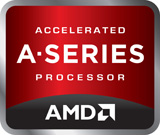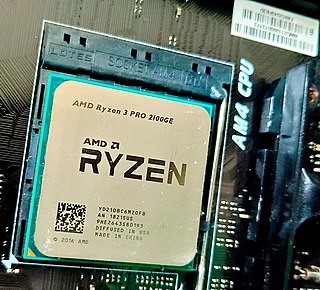Related Research Articles

Advanced Micro Devices, Inc., commonly abbreviated as AMD, is an American multinational semiconductor company based in Santa Clara, California, that develops computer processors and related technologies for business and consumer markets.

Athlon is the brand name applied to a series of x86-compatible microprocessors designed and manufactured by AMD. The original Athlon was the first seventh-generation x86 processor and the first desktop processor to reach speeds of one gigahertz (GHz). It made its debut as AMD's high-end processor brand on June 23, 1999. Over the years AMD has used the Athlon name with the 64-bit Athlon 64 architecture, the Athlon II, and Accelerated Processing Unit (APU) chips targeting the Socket AM1 desktop SoC architecture, and Socket AM4 Zen microarchitecture. The modern Zen-based Athlon with a Radeon Graphics processor was introduced in 2019 as AMD's highest-performance entry-level processor.
The AMD K8 Hammer, also code-named SledgeHammer, is a computer processor microarchitecture designed by AMD as the successor to the AMD K7 Athlon microarchitecture. The K8 was the first implementation of the AMD64 64-bit extension to the x86 instruction set architecture.
The AMD Family 10h, or K10, is a microprocessor microarchitecture by AMD based on the K8 microarchitecture. The first third-generation Opteron products for servers were launched on September 10, 2007, with the Phenom processors for desktops following and launching on November 11, 2007 as the immediate successors to the K8 series of processors.

AMD Accelerated Processing Unit (APU), formerly known as Fusion, is a series of 64-bit microprocessors from Advanced Micro Devices (AMD), combining a general-purpose AMD64 central processing unit (CPU) and 3D integrated graphics processing unit (IGPU) on a single die.
The AMD Bulldozer Family 15h is a microprocessor microarchitecture for the FX and Opteron line of processors, developed by AMD for the desktop and server markets. Bulldozer is the codename for this family of microarchitectures. It was released on October 12, 2011, as the successor to the K10 microarchitecture.
The FMA instruction set is an extension to the 128 and 256-bit Streaming SIMD Extensions instructions in the x86 microprocessor instruction set to perform fused multiply–add (FMA) operations. There are two variants:
AMD Steamroller Family 15h is a microarchitecture developed by AMD for AMD APUs, which succeeded Piledriver in the beginning of 2014 as the third-generation Bulldozer-based microarchitecture. Steamroller APUs continue to use two-core modules as their predecessors, while aiming at achieving greater levels of parallelism.
AMD Excavator Family 15h is a microarchitecture developed by AMD to succeed Steamroller Family 15h for use in AMD APU processors and normal CPUs. On October 12, 2011, AMD revealed Excavator to be the code name for the fourth-generation Bulldozer-derived core.
Zen is the codename for a family of computer processor microarchitectures from AMD, first launched in February 2017 with the first generation of its Ryzen CPUs. It is used in Ryzen, Ryzen Threadripper, and Epyc (server).

Zen is the codename for the first iteration in a family of computer processor microarchitectures of the same name from AMD. It was first used with their Ryzen series of CPUs in February 2017. The first Zen-based preview system was demonstrated at E3 2016, and first substantially detailed at an event hosted a block away from the Intel Developer Forum 2016. The first Zen-based CPUs, codenamed "Summit Ridge", reached the market in early March 2017, Zen-derived Epyc server processors launched in June 2017 and Zen-based APUs arrived in November 2017.

Socket AM4 is a PGA microprocessor socket used by AMD's central processing units (CPUs) built on the Zen and Excavator microarchitectures.

Zen 2 is a computer processor microarchitecture by AMD. It is the successor of AMD's Zen and Zen+ microarchitectures, and is fabricated on the 7 nm MOSFET node from TSMC. The microarchitecture powers the third generation of Ryzen processors, known as Ryzen 3000 for the mainstream desktop chips, Ryzen 4000U/H and Ryzen 5000U for mobile applications, as Threadripper 3000 for high-end desktop systems, and as Ryzen 4000G for accelerated processing units (APUs). The Ryzen 3000 series CPUs were released on 7 July 2019, while the Zen 2-based Epyc server CPUs were released on 7 August 2019. An additional chip, the Ryzen 9 3950X, was released in November 2019.

Ryzen is a brand of multi-core x86-64 microprocessors designed and marketed by AMD for desktop, mobile, server, and embedded platforms based on the Zen microarchitecture. It consists of central processing units (CPUs) marketed for mainstream, enthusiast, server, and workstation segments and accelerated processing units (APUs) marketed for mainstream and entry-level segments and embedded systems applications.
Zen+ is the codename for a computer processor microarchitecture by AMD. It is the successor to the first gen Zen microarchitecture, and was first released in April 2018, powering the second generation of Ryzen processors, known as Ryzen 2000 for mainstream desktop systems, Threadripper 2000 for high-end desktop setups and Ryzen 3000G for accelerated processing units (APUs).

Zen 4 is the codename for a CPU microarchitecture designed by AMD, released on September 27, 2022. It is the successor to Zen 3 and uses TSMC's N5 process for CCDs. Zen 4 powers Ryzen 7000 mainstream desktop processors and will be used in high-end mobile processors, thin & light mobile processors, as well as Epyc 9004 server processors.
References
- ↑ Hesseldahl, Arik (2000-07-06). "Why Cool Chip Code Names Die". forbes.com. Retrieved 2007-07-14.
- ↑ "List of AMD CPU microarchitectures - LeonStudio". LeonStudio - CodeFun. 3 August 2014. Retrieved 12 September 2015.
- ↑ "AMD Unveils 'Chiplet' Design Approach: 7nm Zen 2 Cores Meet 14 nm I/O Die". AnandTech. 2018-11-06. Retrieved 2020-10-12.
- ↑ "AMD Launches AMD Ryzen 5000 Series Desktop Processors: The Fastest Gaming CPUs in the World" (Press release). Santa Clara, California: Advanced Micro Devices, Inc. 2020-10-08. Retrieved 2020-10-12.
- ↑ "AMD Zen 4 processors could destroy Intel thanks to their 5nm designs". TechRadar. 2020-03-25. Retrieved 2020-12-10.
- ↑ "AMD confirms Zen4 & Ryzen 7000 series lineup: Raphael in 2022, Dragon Range and Phoenix in 2023". videocardz.com. May 3, 2022.